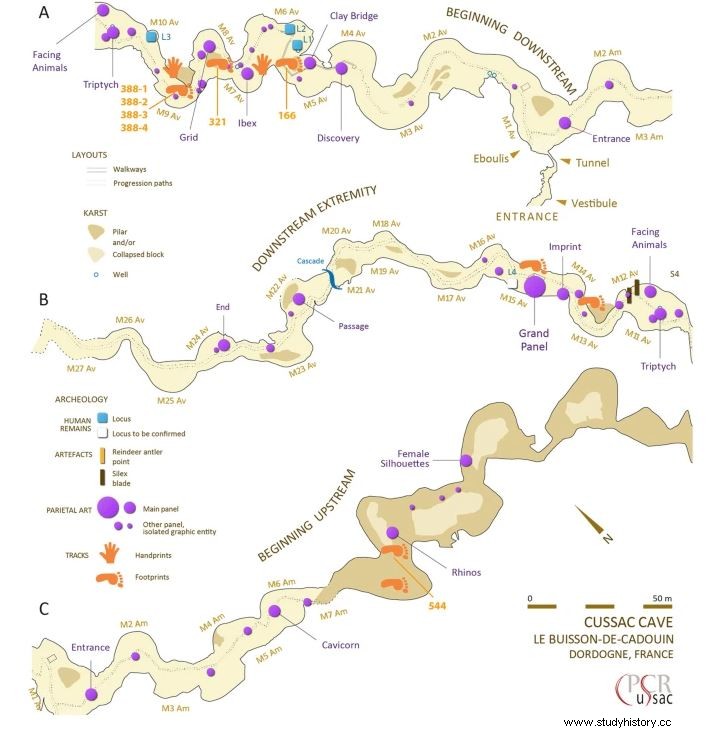Soft moccasins were used in the Gravettian era 30,000 years ago. This is convincingly demonstrated by the identification of footprints in the cave of Cussac (Dordogne).

Depth and contour maps of "shod" footprints discovered in Cussac Cave, Dordogne Valley.
They are seven! Seven footprints imprinted in the clay soils of the long corridors of the Cussac cave, in the heart of Périgord, south of the Dordogne valley. Seven traces of "shoes" and not "bare" feet, as the prehistoric archives have accustomed us to, like those identified in the caves of Pech-Merle (Lot), or Niaux and Fontanet (Ariège). Famous for its hundreds of monumental prehistoric engravings, and its deposits of human bones intentionally placed in ancient bear dens, the exceptional European Paleolithic sanctuary that is Cussac has once again delivered an astonishing discovery.

Some of the 800 engravings from the Gravettian period adorning the walls of the prehistoric cave of Cussac, in the Dordogne valley. ©PACEA
Revealed in an article in the journal Scientific Reports, Lysianna Ledoux, a young researcher from LabEx-PACEA* at the University of Bordeaux, describes the analysis of traces left by a visitor at least 30,000 years ago, during the so-called Gravettian period. Everything indicates that he or she was wearing shoes. Soft shoes like leather moccasins. This was already suggested by the spectacular burials of Sunghir, east of Moscow, dated 29,000 years ago:the arrangement of thousands of beads sewn on skin clothing -by nature perishable-, some of which were found around the feet , suggested the probable wearing of shoes by these inhabitants of the steppes contemporary with those of Cussac. But "direct" evidence of their use had never been described for such early periods.

Map of location of footprints (in orange), within the 1.6km of galleries in the Cussac cave. © PACEA
"Whether it is the origin of clothing or footwear in the Late Palaeolithic, our knowledge is indeed essentially based on indirect evidence associated with hide working, with the discovery of tools fashioned from stone or bone, like needles" , explains the prehistorian and university professor, Jacques Jaubert, director of the Cussac project, co-signer of the article.

Two of the "shod" footprints. © PACEA
The oldest leather shoe that has come down to us, found in Armenia at the site of Areni-1, does not date back beyond 3627 years before our era. And those that wrapped the feet of Ötzi, the ice mummy found in 1991, in the Otzal massif, on the border of Italy and Austria, are 5300 years old.
At Cussac, the imprints of three left feet and four right shod feet have been preserved in the sediments of the cave. To go further, the researchers carried out numerous experiments on the same types of clay sediments:they walked barefoot - which systematically reveals the trace of the toes -, or with soft leather shoes. The results obtained confirm that the wearing of shoes directly affects the geometry and the biometrics of the traces, by modifying the imprint of the arch of the foot and leaving imprints that are always longer and shallower than those of bare feet.
*PACEA:From Prehistory to the Present:Culture, Environment and Anthropology
